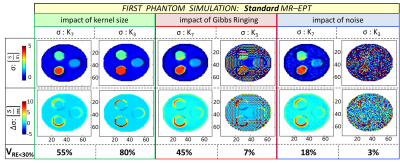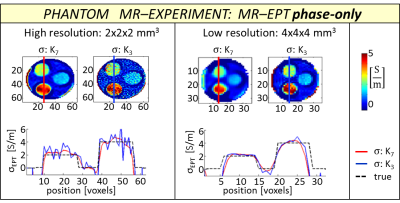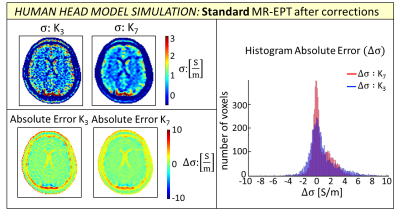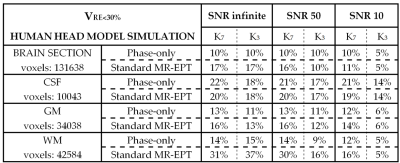5097
Error Analysis of Helmholtz-based MR-Electrical Properties Tomography1Center for Image Sciences, UMC Utrecht, Utrecht, Netherlands, 2Philips Research Laboratories, Hamburg, Germany
Synopsis
The numerical error arising from the computation of spatial derivatives using finite difference kernels is investigated for Helmholtz-based MR-Electrical-Properties-Tomography conductivity reconstructions. We show that this numerical error is one major cause of limited accuracy in Helmholtz-based MR-EPT reconstructions, even if mitigation strategies such as Gibbs ringing correction and Gaussian apodization in k-space are adopted. Ultimately, large derivative kernels lead to more noise-robust conductivity reconstructions, at the cost of more spatially-extended boundary errors. If boundaries are not explicitly taken into account during reconstructions, the accuracy of MR-EPT is severely hampered, particularly for spatially convoluted tissues such as the human brain.
Introduction
MR-Electrical Properties Tomography (MR-EPT) aims to measure tissue electrical properties (EPs: conductivity σ, and permittivity ε) at RF frequencies (64-300 MHz) using MR-scanners1. This technique has already been applied in in-vivo studies2-5. However, the presented results show large variability in the reconstructed EPs values6-9. Helmholtz-based MR-EPT reconstructions are performed by computing spatial derivatives of the complex transmit RF field (B1+), i.e. by convolving the acquired MR images with finite difference (FD) derivative kernels10,11. This derivative operation is very sensitive to spatial fluctuations caused by noise and Gibbs ringing (GR). Moreover, at tissue boundaries, FD kernels include voxels that belong to regions with different EPs. In this work, the error arising from the computation of spatial derivatives using finite difference kernels (FD error) has been investigated for Helmholtz-based MR-EPT conductivity reconstructions. It is also investigated whether mitigation strategies such as GR correction12 and Gaussian apodization (GA) in k-space13 can be beneficial.Methods
Standard MR-EPT conductivity reconstructions were performed according to1:
$$σ(\mathbf{r})≈\frac{1}{μ_{0}ω}Im(\frac{\triangledown^2B_1^+(\mathbf{r})}{B_1^+(\mathbf{r})})≈\frac{1}{μ_{0}ω}Im(\frac{B_1^+(\mathbf{r})*K}{B_1^+(\mathbf{r})})$$
and phase-only conductivity reconstructions were performed according to1:
$$σ(\mathbf{r})≈\frac{1}{μ_{0}ω}Im(\frac{\triangledown^2e^{iφ^+(\mathbf{r})}}{e^{iφ^+(\mathbf{r})}})≈\frac{1}{μ_{0}ω}Im(\frac{e^{iφ^+(\mathbf{r})}*K}{e^{iφ^+(\mathbf{r})}})$$
with φ+: B1+ phase, K: 2nd order FD kernel (K3: 3×3×3 voxels, and K7: 7×7×5 voxels)14, ω: frequency, and μ0: vacuum permeability.
FDTD simulations were performed in Sim4Life (ZMT, Zurich) on a cylindrical model and on a human head model (Duke, Virtual Family) with piecewise constant EPs. Simulations were used to evaluate the accuracy of MR-EPT reconstructions, as they allow knowledge of the ground truth (i.e. input EPs values). We defined with VRE<30% the percentage of voxels with relative error < 30%.
First phantom simulation: we evaluated the impact of FD kernel size, Gibbs ringing, and superimposed noise (B1+ magnitude SNR = 30) on standard MR-EPT reconstructions.
Second phantom simulation: we evaluated whether GR-correction12 and k-space-GA13 improve the reconstruction accuracy (VRE<30%) as a function of the voxel size. Phase-only conductivity reconstructions were performed to allow comparison with MR-measurements.
Human head model simulation: we evaluated the accuracy (VRE<30%) of both standard and phase-only MR-EPT conductivity reconstructions as a function of SNR and FD kernel size, after the aforementioned mitigation strategies were applied.
From MR-measurements (3T, Ingenia, Philips) on an agar-based phantom, phase-only conductivity reconstructions were performed, employing the transceive phase assumption14. Two single-slice, Spin-Echo phase maps acquired with opposite readout gradient polarities were combined to compute the RF phase maps used for phase-only conductivity reconstructions: TR/TE = 900/5 ms, field of view = 256×256 mm2, voxel size = 2×2×2 mm3 and 4×4×4 mm3 for the high and low-resolution experiments, respectively.
Results and Discussion
Fig. 1 shows that MR-EPT conductivity reconstructions are accurate inside homogeneous regions for the noiseless case (absolute error ∆σ ≈ 0 S/m, VRE<30% > 55%). However, given realistic conditions, the small FD kernel is highly sensitive to Gibbs ringing and noise, whereas the large, noise-robust FD kernel leads to extended boundary errors (VRE<30% ≈ 3% for K3, and 18% for K7).
Fig. 2 shows that K7 performs globally better than K3 for realistic conditions, since it is more noise-robust. K-space-GA helps improving the accuracy for high resolution reconstructions, while the accuracy is improved by GR-correction for low resolution reconstructions. Still, VRE<30% is not higher than 20% even after applying mitigation strategies.
Phase-only conductivity reconstructions from phantom MR-measurements after these mitigation strategies were applied (Fig. 3) confirm the results observed in the second phantom simulation.
In Fig. 4, standard MR-EPT reconstructions on a head model and absolute error maps are presented after GR-correction and k-space-GA. The impact of spatial fluctuations is reduced inside large homogeneous regions such as the WM if K7 is used, compared to K3 reconstructions. However, more boundary error propagation is introduced. This limits the reconstruction accuracy for spatially convoluted tissues such as the GM and the CSF.
In Tab. 1, the reported VRE<30% values for standard and phase-only MR-EPT conductivity reconstructions indicate that the global accuracy is generally low and does not substantially improve with increasing SNR levels. Ultimately, even for the WM, which is the largest homogeneous tissue in the brain, VRE<30% is at most 37%.
Conclusions
The numerical error introduced by the computation of spatial derivatives using FD kernels is one of the major causes of limited accuracy in Helmholtz-based MR-EPT reconstructions, even if mitigation strategies are adopted. Increasing FD kernel size leads to more noise-robust reconstructions, at the cost of more extended boundary errors. If boundaries are not taken into account explicitly during reconstruction, the accuracy of MR-EPT is severely hampered, particularly for spatially convoluted tissues such as the human brain.Acknowledgements
The authors would like to thank Janot P. Tokaya, Ettore F. Meliado and Astrid L.H.M.W. van Lier for constructive discussions.References
1. Katscher U, van den Berg C a. T. Electric properties tomography: Biochemical, physical and technical background, evaluation and clinical applications. NMR Biomed. 2017: early view. doi: 10.1002/nbm.3729.
2. Shin J, Kim MJ, Lee J, Nam Y, Kim M, Choi N, Kim S, Kim D-H. Initial study on in vivo conductivity mapping of breast cancer using MRI. J. Magn. Reson. Imaging 2014:371–378. doi: 10.1002/jmri.24803.
3. Van Lier ALHMW, Hoogduin JM, Polders DL, Boer VO, Hendrikse J, Robe PA, Woerdeman PA, Lagendijk JJW, Luijten PR, van den Berg CAT. Electrical conductivity imaging of brain tumours. Proc. 19th Annu. Meet. ISMRM. Montréal, Québec, Canada 2011;19:4464.
4. Tha KK, Katscher U, Yamaguchi S, Stehning C, Terasaka S, Fujima N, Kudo K, Kazumata K, Yamamoto T, Van Cauteren M, Shirato H. Noninvasive electrical conductivity measurement by MRI: a test of its validity and the electrical conductivity characteristics of glioma. Eur Radiol. 2017 Jul 11. doi: 10.1007/s00330-017-4942-5
5. Balidemaj E, de Boer P, van Lier a LHMW, Remis RF, Stalpers LJ a, Westerveld GH, Nederveen a J, van den Berg C a T, Crezee J. In vivo electric conductivity of cervical cancer patients based on B1+ maps at 3T MRI. Phys. Med. Biol. 2016;61:1596–1607. doi: 10.1088/ 0031-9155/61/4/1596.
6. Kim D, Choi N, Gho S, Shin J, Liu C. Simultaneous Imaging of In-vivo Conductivity and Susceptibility. Magn. Reson. Med. 2014;71:1144–1150. doi: 10.1002/mrm.24759.
7. Lee J, Shin J, Kim D. MR-Based Conductivity Imaging Using Multiple Receiver Coils. Magn. Reson. Med. 2015. doi: 10.1002/mrm.25891.
8. Van Lier ALHMW, Raaijmakers A, Voigt T, Lagendijk JJW, Katscher U, Van Den Berg CAT. Electric properties tomography in the human brain at 1.5, 3, and 7 T: a comparison study. Magn. Reson. Med. 2014;71:354–363. doi: 10.1002/mrm.24637.
9. Gurler N, Ider YZ. Gradient-Based Electrical Conductivity Imaging Using MR Phase. Magn. Reson. Med. 2016;00:00–00. doi: 10.1002/mrm.26097.
10. Duan S, Xu C, Deng G, Wang J, Liu F, Xin SX. Quantitative analysis of the reconstruction errors of the currently popular algorithm of magnetic resonance electrical property tomography at the interfaces of adjacent tissues. NMR Biomed. 2016:744–750. doi: 10.1002/nbm.3522.
11. Lee S, Bulumulla S, Hancu I. Theoretical Investigation of Random Noise-Limited Signal-to-Noise Ratio in MR-Based Electrical Properties Tomography. IEEE Trans. Med. Imaging 2015;34:2220–2232.
12. Kellner E, Dhital B, Kiselev VG, Reisert M. Gibbs-ringing artifact removal based on local subvoxel-shifts. Magn. Reson. Med. 2015; 76:1574–1581. doi: 10.1002/mrm.26054.
13. Mandija S, Sbrizzi A, van Lier ALHMW, Luijten PR, van den Berg CAT. Proc. 24th Sci. Meet. Int. Soc. Magn. Reson. Med. Singapore, 2016:2989.
14. van Lier ALHMW, Brunner DO, Pruessmann KP, Klomp DWJ, Luijten PR, Lagendijk JJW, Van Den Berg CAT. B1+ phase mapping at 7 T and its application for in vivo electrical conductivity mapping. Magn. Reson. Med. 2012;67:552–561. doi: 10.1002/mrm.22995.
Figures




